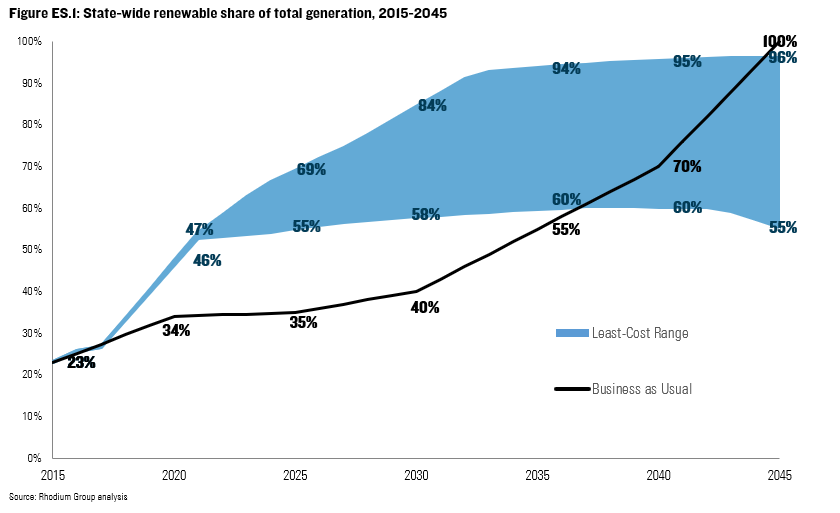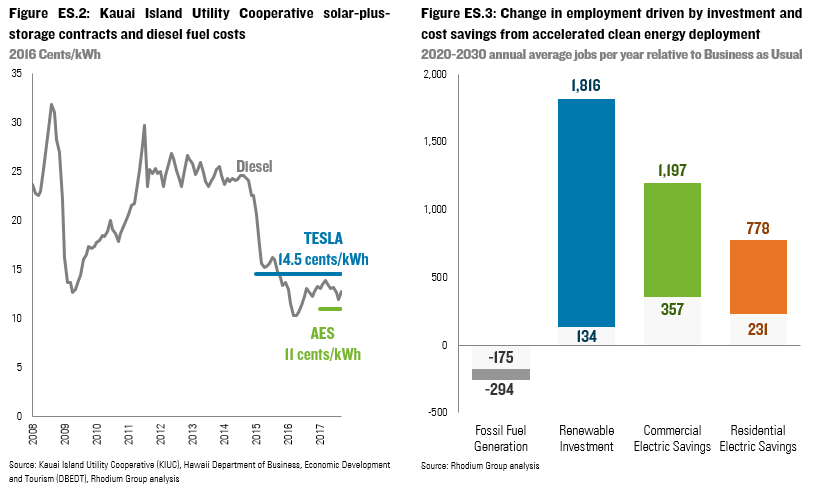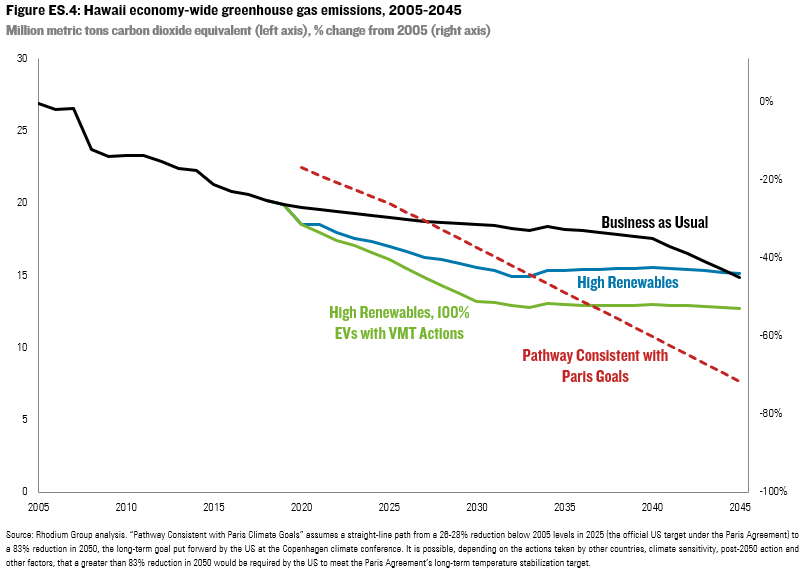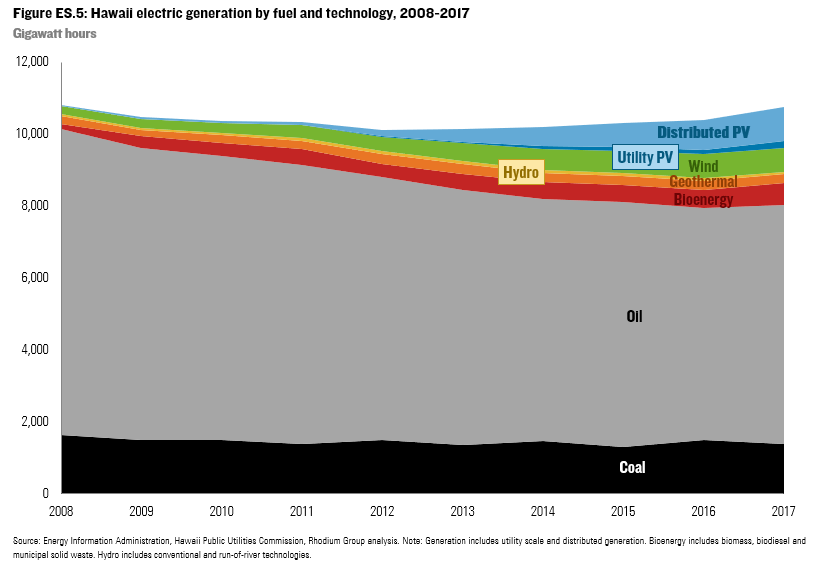Transcending Oil: Hawaii’s Path to a Clean Energy Economy
From Rhodium Group, April 19, 2018
An ocean apart from the US mainland’s electric supply, Hawaii has embarked on an ambitious effort to wean itself off imported fossil fuels. Dependence on oil has been a defining feature of Hawaii’s energy system since before its 1959 statehood. As a result, Hawaii’s electricity prices have been among the highest and most volatile in the nation. Over the past 15 years, the people of Hawaii have paid 260% more for electricity than the US average, while gasoline prices consistently hover close to $1-per-gallon higher.
Hawaii has already begun to usher in a new era of energy independence. It is the only state in the nation with a mandate to reach 100% renewable electricity in place, with a deadline of 2045. The last ten years have seen steady progress toward that goal. In 2008, the Hawaii Clean Energy Initiative, a partnership between the State of Hawaii and the US Department of Energy (DOE), launched with the goal of transforming Hawaii’s energy ecosystem. Innovators in Hawaii, seeking to mitigate climate change and make the state more resilient, have created opportunities for new clean energy technologies and novel business models to thrive in the state.
Elemental Excelerator commissioned Rhodium Group, in partnership with Smart Growth America, to conduct an independent analysis of Hawaii’s clean energy transition. To do this, we leveraged state-of-the-art energy system and economic modeling tools, state and federal datasets, existing literature and nearly 200 hours of interviews and meetings with Hawaii stakeholders and experts. This is not a plan; rather, this report presents a quantitative assessment of accomplishments to date and describes the future potential of clean energy deployment in Hawaii’s electric power sector and on-road transportation.
The Path Ahead: Cheaper to Go Faster
What does the future hold for Hawaii? We find it is cheaper to accelerate the clean energy transition than cruise toward the 2045 renewables targets. After considering a range of energy sector cost projections, we find Hawaii’s most cost-effective pathway would source from 58 to 84% of its electricity from renewable energy by 2030 (Figure ES.1). That could amount to double the mandate of Hawaii’s current Renewable Portfolio Standard, which calls for 40% renewable energy by 2030. Supplying a full 100% of the state’s electricity from renewable sources as early as 2030 would be more expensive than this 58 to 84% range, but cheaper than the current energy mix or current RPS under most oil price and renewable energy cost futures.

Why is this the case? Innovation and scaled deployment have slashed the cost of renewables so much that they are cheaper than oil in many applications. Recent clean power purchase agreements prices are lower than the price of conventional power plant fuels (Figure ES.2).
Accelerating the clean energy transition will bring real economic and environmental benefits including:
- Increasing investment in clean energy up to an additional $2.9 billion. Accelerating clean energy deployment from 2020 to 2030 will bring new investments and will reduce the amount of money sent offshore for imported oil.
- Adding thousands of new good-paying jobs. New investment brings employment opportunities across the state. Hawaii could see a net increase in average annual statewide employment of 1,522 jobs from new clean energy investment (Figure ES.3). Energy cost savings could increase yearly average employment by an additional 500 to 2,000 jobs.

- Creating a strong platform for innovation. More innovation will be necessary to achieve a 100% renewable energy future. Hawaii has an opportunity to position itself at the forefront of energy innovation and compete globally for talent and investment.
- Meeting Hawaii’s Paris Commitment. While Hawaii is on track to meet its share of America’s 2025 target under the Paris Agreement, under a “business-as-usual” scenario the state is not on a path to reduce emissions to levels consistent with the Paris Agreement’s long-term temperature targets. Hawaii needs to accelerate its clean energy transition and address its oil dependence in both the electric and the ground transportation sectors if it is going to maintain progress towards these goals (Figure ES.4).

The Road Ahead: Doubling Down on Mobility
The pace of the transportation clean energy transition has been slower than in electric power. While Hawaii has taken steps to expand mobility options across the state, total transportation demand is increasing. Federal standards have helped to keep oil consumption flat despite growth in travel demand. The state ranks second in the nation in electric vehicles per capita fueled in part by state and county incentives and $10,000 rebates offered by Hawaiian Electric. Hawaiian Electric’s Electrification of Transportation roadmap projects that 55% of cars on the road in 2045 will be electric. Last year, each county in Hawaii proclaimed a goal of 100% renewable ground transportation by 2045.
Looking to the future, we find that transportation demand will continue to increase without new efforts to expand mobility and improve the prevalence of dense, mixed-use development. By coupling these actions with accelerated sales of EVs, in line with the county-level proclamation, Hawaii could cut its oil dependence in the ground transportation sector to zero by 2045. This can be achieved while still capturing the benefits of accelerating clean energy in the electric power sector.
New Action is Needed
Hawaii has a strong track record of setting ambitious goals in electricity and transportation, but to capture the benefits of accelerating the clean energy transition new action by the state, counties, communities, and individuals are required. These actions can improve existing policy frameworks and create new ones that provide certainty for businesses, opportunities for new technologies and incentives to make an accelerated clean energy transition a reality. These actions fall into three categories:
Phase out fossil fuels:
- Accelerate renewable energy targets. Revise Hawaii’s renewable energy mandate to align with current clean energy economics. Our analysis shows that it is cheaper to use less oil in the electric sector than current policy mandates require through at least 2037.
- Adopt Zero Emission Vehicle standards. Join nine other states in adopting California’s ZEV standards to require more EVs be sold in the state by 2025.
- Follow through and build on clean transportation commitments. Hawaii’s mayors have pledged to electrify public vehicle fleets by 2035. Meeting these goals and extending them to private fleets, and possibly automated vehicles will accelerate EV deployment in the state.
Realign incentives with clean energy goals:
- Revise utility regulatory frameworks to create an open grid. Change utility regulations to let the utility profit from cutting oil consumption. Lift limits on distributed energy and establish fair compensation for those resources, especially rooftop solar, so these technologies can deliver all the system benefits they have the potential to provide.
- Create an open data environment. Encourage the creation of open data between the utility and government, which will enable more efficient markets and attract local and global innovators.
- Engage now in a multi-sector, long-term integrated energy plan. Proactively engaging all stakeholders in the development of a comprehensive energy plan for the state will give public and private sector actors needed certainty for investment decisions. Identifying and working through tradeoffs between land-use, energy production priorities and community needs should be a central focus of this process.
- Put a price on carbon. A carbon tax could generate revenue that stays in Hawaii. That funding stream can serve for a variety of purposes such as dividend payments to local residents, clean energy development and other projects that combat the harmful impacts of climate change.
Tackle transportation demand
- Revise state and county land use and transportation policies to incentivize multimodal mobility and disincentive (sic) car ownership. Revising subdivision ordinances and zoning to improve mobility options, incentivize land-uses and enhance connectivity can reduce transportation demand growth.
- Price the full cost of parking and driving. Half the VMT reductions considered in our analysis come from pricing mechanisms. Parking management plans should be established, and minimum parking requirements in new developments should be removed, as they add to housing costs and incentivize personal vehicle ownership. Congestion charges potentially coupled with VMT charges tailored to reward ride-sharing could be useful in shoring up lost gasoline tax revenue while also reducing transportation demand.
- Design public streets for everyone (except drivers-- Editor). Public streets are the most underutilized public asset. Future road maintenance and new road construction should support a multimodal system of transportation including pedestrian, bicycle lanes, bike share, car share, ride-hailing, bus, rail, and EV charging.
Hawaii is Already Reaping the Rewards of the Clean Energy Transition
Since 2008, clean energy has surged in Hawaii due to falling costs, policy leadership, and innovation. Renewable energy now makes up 25% of all the power generated in Hawaii up from 6% in 2008 (Figure ES.5). Nearly one thousand gigawatt hours of electricity savings have been captured through energy efficiency investments. That is almost enough electricity to power the Big Island for one year. Hawaii committed to accelerate this transition and put the state on track to do its part in meeting long-term US greenhouse gas (GHG) emission reduction goals, with a commitment to achieve 100% renewable energy by 2045. These combined achievements have produced real benefits including:
- Hawaii now has nearly 16,000 clean energy jobs. There are twice as many people working as rooftop solar installers, energy efficiency contractors, and renewable fuel producers than people employed in fossil energy. Energy jobs on average pay $3- to $7-per-hour better than the median wage, so this growth in clean energy employment has helped support living wages in Hawaii.
- Hawaii saved over 2.5 million metric tons of GHG emissions from 2010 to 2015. The state has cut total emissions by 20% from 2005 levels (why pick 2005 since Clean Energy Initiative launced in 2008?), outperforming the US as a whole. (Reality for the Few Who Can Handle it: Clean Energy Fail: While Most States Clean Up, Hawaii CO2 Emissions Rise Since '08)

Download the Technical Appendix [PDF]
PBN: Report says Hawaii can reach renewable energy goal faster, and cheaper
IM: Elemental Excelerator Issues Report on Hawaii Energy Path
Reality for the Few Who Can Handle it: Clean Energy Fail: While Most States Clean Up, Hawaii CO2 Emissions Rise Since '08